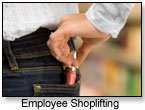 |

Tools:








What Every Retailer Ought to Know About Five-Finger DiscountsHow to Curb Shoplifting and Employee Theft
The following article was reprinted with permission from the author.
Shrink: It’s what the retail industry calls “loss.” It is a broad category used to encompass disappearing merchandise from shoplifting customers, employees not ringing up merch correctly, employees not checking invoices to packing lists, employees giving their employee discount to friends and family, transfers that are sent to another store but never taken out of the original store’s inventory and probably most importantly – employees stealing.
 Yes, employees stealing. Yes, employees stealing.
Oh, I know, not yours. I used to think so myself until…
Strange Behavior
I was working with a small boutique hotel and had an occasion to meet with the Front Desk manager Larry and the owner. When we told Larry, he immediately became fearful, “Why?, What’s up?”
When we got to the room and sat down, the color had drained from his face which I thought was strange. The owner began by talking about occupancy and rates when Larry butted in, “So you aren’t going to fire me?” The owner looked to me and then Larry, “No, why?” He answered, “Oh, it just seemed the way you guys were wanting to meet with me, something was wrong.”
That meeting was so odd we decided to look over the daily “night audit;” the report that showed every transaction that took place each day. And that’s when we found it. In the past week, rooms were being refunded in the morning yet the charges were still going through on the guest’s credit card. It was one of the oldest ways to steal there is; issuing fraudulent credits and pocketing the rest. Shame on us for not monitoring daily.
Self-Driven Raises
When times are tough employees feel emboldened to take the raise they feel they deserve; especially if they are part-timers.
The new way to do this is to credit a gift card for the return. The New York Times recently covered the phenomenon at Saks in Manhattan. One of the most shocking figures they presented was that “larcenous employees averaged $1,890 in theft, compared with $438 for shoplifters.”
Yet when’s the last time you checked your systems for theft? Here are six of my tips:
- Never let someone take out the trash themselves; its one of the easiest places to conceal stolen product. At the very least occasionally check.
- Monitor your reports for gift card sales; we’re past the holidays and you should easily be able to catch extremes.
- Make random counts of your cash drawers; if they are over or short write them up quickly.
- If you use coupons, do something to keep them from being used over and over like disgruntled employees are likely to do for friends and family.
- Limit paper at the registers that cashiers could copy down information; better yet let the customer swipe their own card on a terminal facing the customer so the card is in clear view of the owners at all times. Then have the cashier check that the last four numbers match the front of the card.
- If you have overhead cameras, check the number of items on a receipt match the number of the items in the bag.
- Limit your number of part-timers; the more hours they work, the more bonded they’ll be to your operation.
I’m not advocating going overboard on this and installing surveillance cameras everywhere but I am advocating that “ignorance is bliss” is not true when it comes to employee shrink. And it isn’t always cash, I’ve heard of cases of frozen dough, milk, samples of window coverings – the works end up being lifted.
Oh and one more thing, when you find them and you can document the loss, give them the option to pay restitution by signing an admission of guilt or going to the police. Only if they get caught will they stop.
Managing risk is as important as growing sales if you want to be profitable but maybe your personality style is getting in the way. That’s why my new book, the "Retail Doctor’s Guide to Growing Your Business," pulls back the cover of how your personality can determine your businesses health.
 Writer's Bio: Writer's Bio: Bob Phibbs is the Retail Doctor®, a best-selling author and speaker who has helped thousands of independent businesses compete. His new book, The Retail Doctor’s Guide to Growing Your Business has received praise from both Inc. magazine and USA Today and can be found at your local bookstore or ordered at http://www.retaildoc.com/guide. He and his work have been featured in the New York Times, the Wall Street Journal and Entrepreneur magazine. Questions? Contact Bob at info@retaildoc.com. This article was reprinted with permission of the author, Bob Phibbs, aka The Retail Doctor®. Read more articles by this author
THIS BANNER IS AN AD:

Back to TDmonthly's front page
|  |
Advertise on TDmonthly

|

